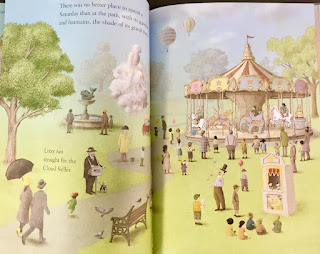By The Fan Brothers
(Simon & Schuster Books for Young Readers, 2022)
One of first picture books I blogged about was Cloudette by Tom Lichtenheld (better known for illustrating books like Shark vs. Train and Goodnight, Goodnight, Construction Site). I loved the novelty of making a cloud a picture book character. Now The Fan Brothers have added another picture book to the cloud canon—might that include Cloudy with a Chance of Meatballs?—with Lizzy and the Cloud. This time, the cloud is Milo.
The story opens with young Lizzy heading to the park with her parents on a Saturday afternoon. The double spread showing the park looks very traditional, harkening back to an earlier time. I immediately thought of retro spinning tops I’ve seen in toy stores. While a large carousel will first draw readers’ eyes, the text calls attention to the Cloud Seller, the only person getting wet on the sunny day. He’s in a raincoat and boots because he’s holding stringed clouds which float above him much like a balloon seller in parks nowadays.
The story goes on to explain, “Most people were in a rush to get to the new carousel or the puppet show. Clouds were a bit out of fashion these days, but not to Lizzy.” I’m with Lizzy. As the Cloud Seller and his wares get a zoom-in shot, it’s hard to conceive of why animal clouds wouldn’t be the star attraction. One boy walks off with an octopus cloud, but Lizzy wants “an ordinary cloud,” resembling nothing more than a blob but temporarily sporting a miniature rainbow below it. Way cooler than a performance with sock puppets.
Turning pages, we discover why the entire ambience feels old-fashioned. This is indeed an earlier time, the main street home to a shoe repair and a market that sells oranges for a cent. A man in a suit and top hat navigates the road on a penny-farthing while something like a Model T sedan is parked outside the radio shop. A blimp flies overhead with an “Eat at Mo’s Diner” banner trailing behind. I Googled advertising blimps, thinking this might be an anachronism but learned that the first such blimp existed in 1912, promoting Suchard, a Swiss chocolatier. Advertisers are quick to jump aboard the latest innovations.
At home, Lizzy glances at the instructions for cloud care. Rules include, “Water your cloud daily using only fresh clean water. Failure to do so may result in your cloud evaporating into thin air” and, “Clouds are sensitive, and sometimes moody. Thunderstorms are possible if a cloud is unhappy.” Lizzy and Milo coexist, even bond—at least from Lizzy’s perspective—but cloud watering makes Milo grow. He becomes too big and needs his own space in the world. The story ends with a little whimsy.
The illustrations are exquisitely detailed, hand drawn in pencil and colored digitally. Many of them are portrayed in soft greys, with splashes of green and, more commonly, yellow drawing focus to items such as a watering can and Lizzy’s boots. This is a quiet story, enhanced by the subtlety of the art.
Lizzy and the Cloud will stick with the reader just like Milo remains on Lizzy’s mind. Perhaps the next time a young reader gazes up at the clouds, they will see what looks like a parrot, a dog or, less distinctly, Milo. May ordinary clouds come to life in their imagination.




